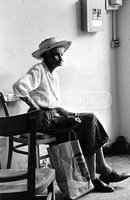

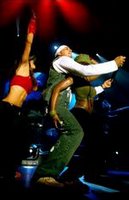
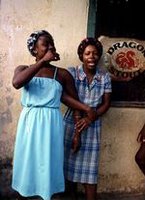

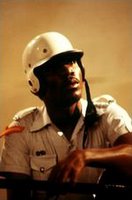

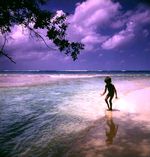
This is a bit long, but someone in my class asked me to repost it. So here it is. If you want a little bit of Jamaican history read below..
Brief History of Jamaica
Compiled from various history books by Donna Essix
I. Pre-Colombian Jamaica
Prior to the arrival of Columbus in 1494, Jamaica was inhabited by Arawaks, living in simple communities based on fishing, hunting, and small scale cultivation of cassava. The impact of the contact with the Spanish was traumatic, and these communities disappeared in 70-80 years. Plunder, disruption of economic activities, new diseases, and migration decimated the indigenous population. Only a few artifacts-facts, examples of which are on display at the small museum at White Marl, and a few Spanish corruptions of place names (such as Ocho Rios) remain from this period. Otherwise, there is no Arawak influence on the subsequent development of life on the island.
II. The Spanish Occupation, 1494-1655
Disappointed by the absence of gold on the island, the Spanish used Jamaica as a base for supporting the conquest of the Americas, particularly Mexico with its treasures of gold and silver. The population of the Spanish settlement, including their slaves, was never large. It was administered from the Town of Santiago de la Vega, now called Spanish Town, and much of the architecture of the original buildings is still evident today in the town square. Economic activity consisted primarily of production for domestic consumption, and to a lesser extent the supply of Spanish ships.
In 1655, it was captured by the British expedition led by Admirals Penn and Venables, following their unsuccessful invasion of Hispaniola. By this time, the island was of little significance to the Spanish crown, and accordingly, very little was done to defend it against the British. As with the previous period, the influence of the Spanish settlement on the subsequent social, economic and political life of the island was marginal. Apart from remnants of buildings with the distinct
Spanish colonial architectural styles, and names of places, there is very little visible evidence of the Spanish occupation.
III. The Slave Economy, 1655-1838
After a brief period of experimenting with indentured European labor, the British turned to large scale importation of Africans to be used as slaves on the sugar plantations. In its hey-day, Jamaica was one of "the jewels in the English crown" because of the fabulous prosperity it brought to the English plantation owners directly, and indirectly to those cities, such as Liverpool and Bristol, which serviced the trade with Jamaica and the rest of the British Caribbean (West Indies). Plantation slavery was based on the Triangular trade among England (manufactured goods), Africa (slaves), and the Caribbean (sugar), which itself was the basis for what later emerged as the international economy. International trade was so important to the Jamaican economy that when the American war of independence disrupted trade between what was then the "North American colonies" and the Caribbean, 15,000 thousands of slaves died of starvation in Jamaica alone.
The plantation dominated economic life in every sense. It occupied the best lands, the laws supported the slave system, and in general all commercial and other economic activity depended on the rhythm of activity of the plantation. Some slaves inevitably ran away from the estates to live in small bands in the mountains as Maroons.
In recognition of her leadership in the Maroon wars against the British, Nanny was eventually named a national hero. Except for the Maroons, all agricultural activity took place on the plantations. The towns served as the commercial sites for the export of sugar and the importation of the inputs for production.
The political system consisted of a governor and his executive council, and an assembly of representatives elected on a limited franchise determined by property ownership. The politics of this period was characterized by an uneasy alliance between the governor as the representative of the crown, and the Assembly of planters, against the slaves. Frequently, the alliance broke down, invariably over taxation of the plantations.
By the close of the 18th century, sugar was losing its economic preeminence because of competition from beet sugar as well as rising production costs. In 1838, the slaves were Emancipated and the plantations had to begin paying wages to its workers. One of Jamaica's national heroes, Rev.Sam Sharpe, after whom Montego Bay's city square is named, is celebrated for his leadership role in the famous Christmas rebellion of slaves in 1831, a few years before Emancipation.
IV. The Development of the Peasantry. 1838-1938
After Emancipation, many of the ex-slaves settled down as small farmers in the mountains, cultivating steep hill slopes far away from the plantations. Still others settled on marginal lands in the plains nearby the plantations on land leased or bought in various land settlement schemes organized and sponsored by Christian groups such as the Baptists.
Struggles over land were central themes in the history of this period, culminating in the Morant Bay rebellion, for which two of Jamaica's national heroes, George William Gordon and Paul Bogle paid with their lives.
In this period, sugar continued its secular decline, but peasant exports of logwood, coffee, and eventually bananas grew steadily. In this way, the economy began to be diversified away from its traditional dependence on sugar alone.
V. The National Movement and Decolonization, 1938-1962
The roots of the national movement for independence reach back into the struggles for land in the 19th century. More immediately, it was inspired by the political ideas and agitation of Marcus Mosiah Garvey, one of Jamaica's national heroes, and precipitated by the reaction of the sugar and dock workers to the economic crisis spawned by the Great Depression. It emerged as a political force in the context of the rebellion in 1938. Its most enduring political institutions, are the two major political parties, and the labor unions affiliated to them. Both the founder of the Jamaica Labor Party (JLP) and the Bustamante Industrial Trades Union (BITU), Alexander Bustamante, and the founder of the People's National Party (PNP) and the National Workers Union (NWU), Norman Manley, have been declared national heroes for their individual and combined efforts in securing political independence from England. The constitutional change that facilitated the emergence of these parties was the granting of adult suffrage and a measure of self-government in 1944.
The period 1944- 1962 not only saw major political changes, but also major transformations of the structure of the economy. From a monocrop export economy, the economy became diversified around the export of sugar, bananas and other agricultural commodities, the export of bauxite and alumina, and the tourist industry. These in turn, stimulated a vibrant construction industry, and an import substituting manufacturing sector. The USA displaced the UK as Jamaica's principal trading partner. There was also a tremendous migration of labor to the UK and the USA which needed labor for the post-war reconstruction and expansion of their economies.
VI. The First Decade of Political Independence, 1962-1972
Political Independence was granted in 1962, following Jamaica's rejection, by referendum, of membership in the Federation of the West Indies. Jamaica was given a Westminister style constitution, with a Governor-general as the representative of the British Crown, and a bicameral Parliament. There is a House of Representatives consisting of elected representatives and a Senate appointed by the Prime Minister and the Leader of the Opposition. The government is headed by a Prime Minister, who is required to consult with the Governor General and the Leader of the Opposition on certain matters. The first two governments were formed by the JLP, which had opposed membership in the Federation.
The post-war boom in the economy continued through the 60's, though it gradually slowed down, with the completion of the investment cycle of the bauxite/alumina industry. By the end of the decade, there were well established mining, tourism, manufacturing, and construction sectors, alongside the traditional agricultural and distribution sectors.
VII. The Second Decade of Political Independence
Between 1972 and 1980, the PNP, the other major political party, held political office and initiated a shift in major economic policies. Most notable was the imposition of the Bauxite Levy in 1974, in order to increase Jamaica's share of the income in that industry. The government positioned the state in the leadership role within the process of economic development, with a view to attenuating and rectifying the inherited economic inequalities.
Related to this was an ideology of social reform to protect the weakest sections of the population, and to promote the welfare of the poor through subsidized food, housing, education, health, and other important social services. In international affairs, Jamaica opened up relations with many non-capitalist countries, and promoted the solidarity of the Third World in international negotiations with the advanced countries.

2 comments:
Good day !.
You may , probably very interested to know how one can reach 2000 per day of income .
There is no need to invest much at first. You may begin to get income with as small sum of money as 20-100 dollars.
AimTrust is what you need
The company incorporates an offshore structure with advanced asset management technologies in production and delivery of pipes for oil and gas.
It is based in Panama with structures around the world.
Do you want to become really rich in short time?
That`s your choice That`s what you desire!
I`m happy and lucky, I started to take up income with the help of this company,
and I invite you to do the same. If it gets down to choose a correct partner utilizes your savings in a right way - that`s the AimTrust!.
I earn US$2,000 per day, and my first investment was 500 dollars only!
It`s easy to get involved , just click this link http://alalefiz.jamminweb.com/izofiv.html
and go! Let`s take this option together to get rid of nastiness of the life
Hi there!
I would like to burn a theme at here. There is such a thing, called HYIP, or High Yield Investment Program. It reminds of financial piramyde, but in rare cases one may happen to meet a company that really pays up to 2% daily not on invested money, but from real profits.
For several years , I make money with the help of these programs.
I don't have problems with money now, but there are heights that must be conquered . I get now up to 2G a day , and my first investment was 500 dollars only.
Right now, I'm very close at catching at last a guaranteed variant to make a sharp rise . Turn to my blog to get additional info.
http://theblogmoney.com
Post a Comment